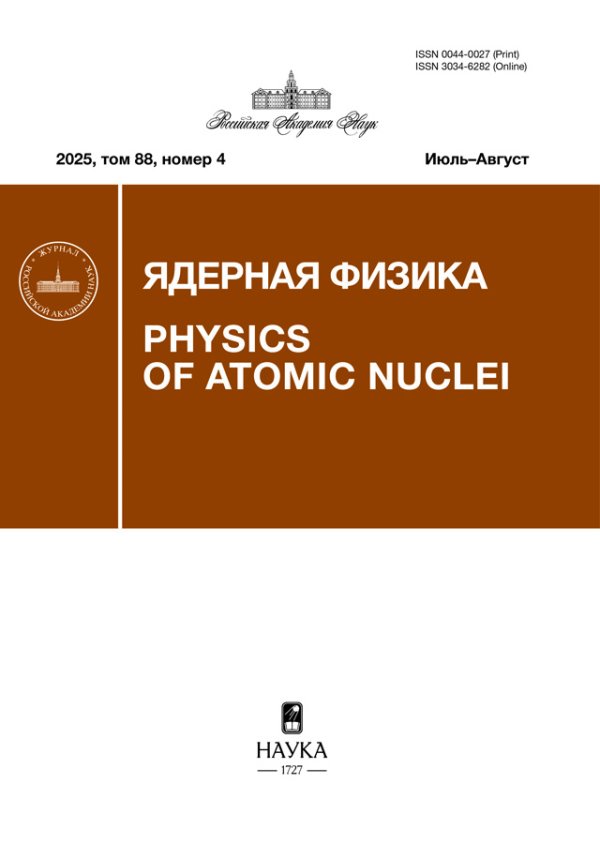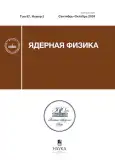ИССЛЕДОВАНИЕ НЕЙТРИНО ВЫСОКИХ ЭНЕРГИЙ НА БОЛЬШОМ АДРОННОМ КОЛЛАЙДЕРЕ
- Авторы: Коновалова Н.С1, Окатьева Н.М1, Полухина Н.Г1, Садыков Ж.Т1, Старков Н.И1, Старкова Е.Н1, Чернявский М.М1, Щедрина Т.В1
-
Учреждения:
- Физический институт им. П.Н. Лебедева РАН
- Выпуск: Том 87, № 5 (2024)
- Страницы: 390-399
- Раздел: ЭЛЕМЕНТАРНЫЕ ЧАСТИЦЫ И ПОЛЯ. Эксперимент
- Статья опубликована: 15.12.2024
- URL: https://gynecology.orscience.ru/0044-0027/article/view/674652
- DOI: https://doi.org/10.31857/S0044002724050043
- EDN: https://elibrary.ru/JFWSAH
- ID: 674652
Цитировать
Полный текст
Аннотация
Об авторах
Н. С Коновалова
Физический институт им. П.Н. Лебедева РАНМосква, Россия
Н. М Окатьева
Физический институт им. П.Н. Лебедева РАНМосква, Россия
Н. Г Полухина
Физический институт им. П.Н. Лебедева РАНМосква, Россия
Ж. Т Садыков
Физический институт им. П.Н. Лебедева РАНМосква, Россия
Н. И Старков
Физический институт им. П.Н. Лебедева РАНМосква, Россия
Е. Н Старкова
Физический институт им. П.Н. Лебедева РАНМосква, Россия
М. М Чернявский
Физический институт им. П.Н. Лебедева РАНМосква, Россия
Т. В Щедрина
Физический институт им. П.Н. Лебедева РАН
Email: tvshchedrina@gmail.com
Москва, Россия
Список литературы
- C. Ahdida, R. Albanese, A. Alexandrov, M. Andreini, A. Anokhina, A. Bay, P. Bestmann, C. Betancourt, I. Bezshyiko, A. Blanco, M. Bogomilov, K. Bondarenko, W. M. Bonivento, P. Boisseaux-Bourgeois, A. Boyarsky, L. Buonocore, et al., Tech. Rep. No. CERN-LHCC-2021-003, No. LHCC-P-016, CERN, Geneva (2021).
- M. Bustamante and A. Connolly, Phys. Rev. Lett. 122, 041101 (2019).
- M. Aaboud, G. Aad, B. Abbott, J. Abdallah, O. Abdinov, B. Abeloos, R. Aben, O. S. AbouZeid, N. L. Abraham, H. Abramowicz, H. Abreu, R. Abreu, Y. Abulaiti, B. S. Acharya, L. Adamczyk, D. L. Adams, et al. (ATLAS Collab.), Eur. Phys. J. C 76, 653 (2016).
- H. Abreu, C. Antel, A. Ariga, T. Ariga, J. Boyd, F. Cadoux, D. W. Casper, X. Chen, A. Coccaro, C. Dozen, P. B. Denton, Y. Favre, J. L. Feng, D. Ferrere, I. Galon, S. Gibson, et al., Eur. Phys. J. C 80, 61 (2020).
- LHCb Collab., LHCb Tracker Upgrade Technical Design Report, Tech. Rep. No. CERN-LHCC-2014-001, No. LHCB-TDR-015, CERN, Geneva (2014).
- A. Ariga, T. Ariga, G. De Lellis, A. Ereditato, and K. Niwa, in: Particle Physics Reference Library, Vol. 2, Detectors for Particles and Radiation, Ed. by C. W. Fabjan and H. Schopper (Elsevier, New York, 2020), p. 383–438.
- W. Bai, M. Diwan, M. V. Garzelli, Y. S. Jeong, and M. H. Reno, J. High Energy Phys. 2006, 032 (2020).
- N. Beni, M. Brucoli, S. Buontempo, V. Cafaro, G. M. Dallavalle, S. Danzeca, G. De Lellis, A. Di Crescenzo, V. Giordano, C. Guandalini, D. Lazic, S. Lo Meo, F. L. Navarria, and Z. Szillasi, J. Phys. G: Nucl. Part. Phys. 46, 115008 (2019).
- N. Beni, M. Brucoli, V. Cafaro, T. Camporesi, F. Cerutti, G. M. Dallavalle, S. Danzeca, A. De Roeck, A. De Rujula, D. Fasanella, V. Giordano, C. Guandalini, A. Ioannisyan, D. Lazic, A. Margotti, S. Lo Meo, et al., J. Phys. G: Nucl. Part. Phys. 47, 125004 (2020).
- L. A. Anchordoqui, A. Ariga, T. Ariga, W. Bai, K. Balazs, B. Batell, J. Boyd, J. Bramante, M. Campanelli, A. Carmona, F. G. Celiberto, G. Chachamis, M. Citron, G. De Lellis, A. De Roeck, H. Dembinski, et al., Phys. Rept. 968, 1 (2022).
- A. Di Crescenzo and G. Galati, Symmetry 15, 1256 (2023).
- A. Boyarsky, O. Mikulenko, M. Ovchynnikov, and L. Shchutska, J. High Energy Phys. 2022, 6 (2022).
- A. Boveia and C. Doglioni, Rev. Nucl. Part. Sci. 68, 1 (2018).
- A. Alexandrov, A. Buonaura, L. Consiglio, N. D’Ambrosio, G. De Lellis, A. Di Crescenzo, G. Galati, V. Gentile, A. Lauria, M. C. Montesi, V. Tioukov, M. Vladymyrov, and E. Voevodina, Sci. Rep. 7(1), 7310 (2017).
- A. Alexandrov, G. De Lellis, and V. Tioukov, Sci. Rep. 9(1), 2870 (2019).
- N. Agafonova et al. (OPERA Collab.), Phys. Rev. Lett. 120, 211801 (2018).
- A. Alexandrov, N. Konovalova, N. Okateva, N. Polukhina, N. Starkov, and T. Shchedrina, Measurement 187, 110244 (2022).
- N. Polukhina, N. Konovalova, and T. Shchedrina, Physics 2023, 499 (2023).
- R. Albanese et al. (SND@LHC Collab.), Phys. Rev. Lett. 131, 031802 (2023).
- H. Abreu et al. (FASER Collab.), Phys. Rev. Lett. 131, 031801 (2023).
- SND@LHC Collab., AdvSND@LHC The Advanced Scattering and Neutrino Detector at High Lumi LHC, Letter of Intent, March 3 (2024).
- CMS Collab., JINST 5, T03015 (2010).
- S. Roesler et al., in: Advanced Monte Carlo for Radiation Physics, Particle Transport Simulation and Applications, Ed. by A. Kling et al. (Springer, Berlin, Heidelberg, 2001).
- A. Ferrari et al., FLUKA: A multi-particle transport code (Program version 2005), Tech. Rep. No. CERN-2005-010, SLAC-R-773, INFN-TC-05-11, CERN, INFN (2005).
- T. T. Bohlen, F. Cerutti, M. P. W. Chin, A. Fasso` , A. Ferrari, P. G. Ortega, A. Mairani, P. R. Sala, G. Smirnov, and V. Vlachoudis, Nucl. Data Sheets 120, 211 (2014).
Дополнительные файлы








